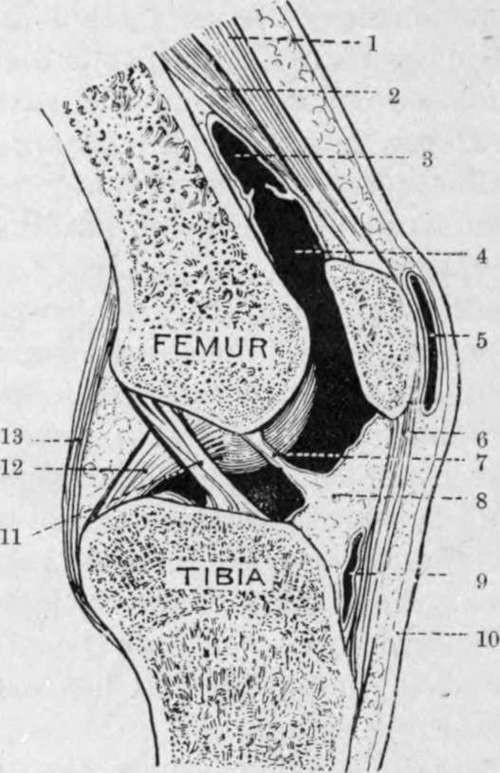The Ligamentum Patella. Fractures Of The Patella
Description
This section is from the book "Surgical Anatomy", by John A. C. MacEwen. Also available from Amazon: Surgical Anatomy.
The Ligamentum Patella. Fractures Of The Patella
The ligamentum patella, some 2 inches in length, is a continuation of the quadriceps tendon over the front of the patella, and also is attached to the apex of the bone, from which it inclines downwards and slightly outwards, to be inserted into the lower part of the tubercle of the tibia, from the upper portion of which it is separated by the infrapatellar bursa, a bursa also sometimes existing between it and the skin. While the posterior surface of the patella as a whole is in communication with the joint, a small portion of the apex, together with the upper third of the ligamentum patellae, is separated from the joint by a pad of fat. The patella is the bone most frequently broken by muscular action, and the majority Of FRACTURES OF THE PATELLA are due to muscular action, the fracture in such cases being transverse, and about the centre of the bone. The accident frequently occurs when, in trying to prevent a fall backwards, the knee is slightly flexed, and the quadriceps acts violently upon the upper extremity of the patella, while the lower is held by the ligamentum patellae. As the patella is only resting on the prominent condyles by its transverse axis, it is snapped rather than torn apart. Unless the expansions from the vasti are also torn, the separation of the fragments is slight. Where the fracture is complete, the prepatellar bursa in front is torn, and the articular cartilage posteriorly, so that the joint cavity is opened, and communicates with the subcutaneous bursa. As the patella is a very vascular bone, a hcemarthrosis frequently occurs, causing much distension of the joint. Attention has already been directed to the expansion of the quadriceps tendon in front of the bone. As the snapping of the bone takes place, this expansion is stretched, and then also snaps, the torn edges being infolded over the broken ends to which they generally adhere firmly. Thus, although the broken surfaces be brought into apposition, each has a layer of fibrous tissue in front of it, and it is on this account that fibrous instead of osseous union of transverse fractures of the patella so frequently occurs. In these cases it is necessary to cut down and elevate the fibrous tissue from the broken surfaces, which will then unite by bone, even if the fragments be only held by stout catgut. The tendency to separation of the fragments is not nearly so great as used to be supposed, and the fact that haemarthrosis frequently occurs sufficiently disposes of the other old explanation of fibrous instead of osseous union that the patella was poorly supplied with blood. Where transverse fracture of the patella occurs close to the apex, it is just possible for the joint to escape.

Fig 39.-Sagittal Section of the Right Knee-Joint, viewed from the Outer Side. (From Buchanan's " Anatomy.")
1. | Crureus. , | 7. | Ligamentum mucosum. |
2. | Subcrureus. | 8. | Infrapatellar pad of fat. |
3. | Suprapatellar bursa. | 9. | Bursa beneath ligamentum patellae. |
4. | Pouch of synovial membrane of knee joint | 10. | Skin. |
11. | Anterior crucial ligament. | ||
5. | Prepatellar bursa. | 12. | Posterior crucial ligament. |
6. | Ligamentum patellae. | 13. | Posterior ligament. |
Oblique, or stellate, fractures of the patella may be due to direct violence ; but in this connection it should be remembered that when one falls on the knee, the tubercle of the tibia, and not the patella, is the part which comes most readily in contact with the ground.
Continue to:
